Long isolated and neutral, Afghanistan before 1973 used an amazing assortment of WWII-era tanks, artillery, and fighting vehicles. In many cases, they remained in Royal Afghan Army use long after they had faded elsewhere in the world.
 (An Afghan FT-17 tank, built by Renault in the 1910s. The AK-47 in the soldier’s hand dates this photo to the 1980s.)
(An Afghan FT-17 tank, built by Renault in the 1910s. The AK-47 in the soldier’s hand dates this photo to the 1980s.)
TANKS
The Disston Tank
This was a product of the USA’s Great Depression. In an effort to stir up badly-needed business, the Disston safe company partnered with Caterpillar to produce an ultra-cheap tank. The Disston Tank was simply the chassis of a Caterpillar Model #35 tractor overlaid with armor made by Disston. It was intended to be armed with a M1916 37mm gun and a machine gun, but the ad hoc design allowed the end user to fit pretty much whatever guns they wanted. As each was hand-assembled, there were differences between each example. With a top speed less than 5mph, the six-ton Disston Tank was more of a mobile pillbox than a tank as we think of one today.
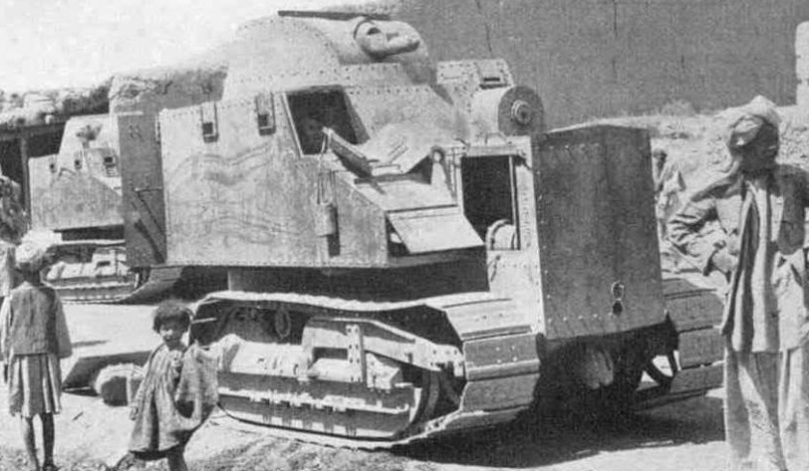 (A pair of Royal Afghan Army Disston Tanks, probably in the 1930s. Both weapon ports are empty; so this photo may have been taken immediately upon delivery.)
(A pair of Royal Afghan Army Disston Tanks, probably in the 1930s. Both weapon ports are empty; so this photo may have been taken immediately upon delivery.)
The US Marine Corps briefly operated sixteen Disston Tanks, some diverted from a cancelled Chinese order. The only other user was Afghanistan. In 1935, the Afghan military bought nine complete Disston Tanks plus three armor shells, which they either intended to be used as damage replacements or (more likely) to somehow be jimmied onto different kinds of tracked chassis already in the country. The tanks were shipped from America by sea to Karachi (today in Pakistan, then in British Raj India), then by rail to the Afghan border.
(A Disston Tank in Kabul during the WWII era, in which Afghanistan remained neutral.)
These lumbering vehicles remained in operational Royal Afghan Army use as late as the 1950s. At least two were still in existence at the end of the 1960s, used as parked training aids. When the USA invaded Afghanistan in 2001, the remains of two Disston Tanks were found. One was a barely-recognizable wreck, the other (below) was relatively intact in a junkyard.
(A junked Disston Tank in Afghanistan during the early 2000s. The “main gun” is just a spare barrel from 61-K 37mm AA gun, welded onto the turret’s weapon port to make the vehicle appear more menacing after it left active service.)
The FT-17
The Renault FT-17 was the world’s first “normal” tank as people today understand the term. Built in France, it differed from earlier huge WWI “land cruisers” in that it was small, economic, and was the first tank in the modern engine-rear, top-turret layout.
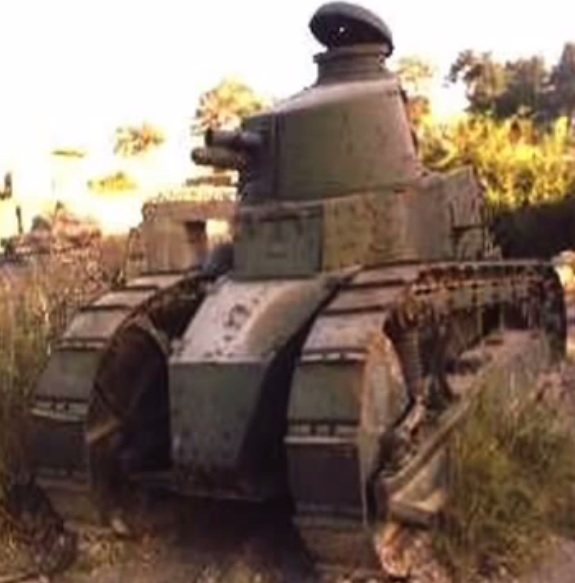 (A long-abandoned Afghan FT-17 found by American troops at Koh-e-Asma, Afghanistan in the early 2000s. It’s believed that this particular FT-17 is the one which later went to Warsaw.)
(A long-abandoned Afghan FT-17 found by American troops at Koh-e-Asma, Afghanistan in the early 2000s. It’s believed that this particular FT-17 is the one which later went to Warsaw.)
The two-man FT-17 weighed 6 ½ tons and was 13′ long. It was armed with a snub-barrelled Puteaux SA18 37mm gun (with 240 rounds ammo), and had riveted steel armor ranging from ½” to just under 1″; sufficient to protect against machine gun bullets of the 1910s but not much else afterwards. The FT-17 used simple steel leaf springs for suspension. It was powered by a Renault 35hp gasoline engine and had a top speed of 6 ½ mph. There was no radio, so to communicate with other units the Afghan tank commanders had to open the hatch and use signal flags.
Afghanistan’s experience with the FT-17 began far away in Europe with the brief 1920 Polish-Soviet War. The USSR captured some FT-17s from the Polish army, but had little desire to keep them afterwards. In 1923, the USSR presented King Amunullah with eight FT-17s.
 (An Afghan FT-17 being transported by a Polish army truck in 2012.)
(An Afghan FT-17 being transported by a Polish army truck in 2012.)
WWII came and went between 1939-1945, and most people forgot that Afghanistan even had these tanks. The Royal Afghan Army continued to use the now-obsolete FT-17 into the 1950s, thereafter slowly retiring them to training duties and then museum pieces. A Soviet officer stationed in Afghanistan during the 1980s war there claimed that for certain, at least one FT-17 was still in drivable use by the DRAA (communist Afghan army).
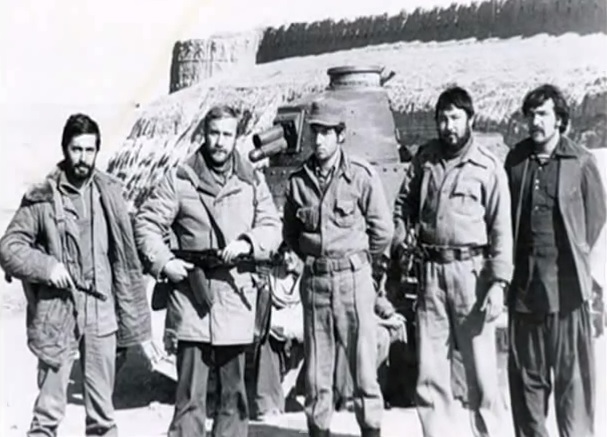 (The above photo was taken at Spin Boldek, Afghanistan, during the 1980s Soviet occupation. The city is near the Afghan/Pakistani border and is a rare look at a FT-17 outside the general Kabul region. A DRAA officer is in the center, flanked by what are most likely Spetsnaz (USSR special forces troops). It’s possible that this is the FT-17 the Soviets claimed was still operational in the 1980s.)
(The above photo was taken at Spin Boldek, Afghanistan, during the 1980s Soviet occupation. The city is near the Afghan/Pakistani border and is a rare look at a FT-17 outside the general Kabul region. A DRAA officer is in the center, flanked by what are most likely Spetsnaz (USSR special forces troops). It’s possible that this is the FT-17 the Soviets claimed was still operational in the 1980s.)
 (This Afghan FT-17 was photographed after the American military liberated Kabul on 14 November 2001. The plinth behind the FT-17’s turret holds an antique Schneider cannon from even earlier in Afghanistan’s military history. Beyond the initial surprise at seeing an actual intact FT-17, much was said of the gun which appears different than seen on any other FT-17 elsewhere. It was suggested that the Soviets had fitted a long-barrel Hotchkiss 37mm gun to one of the FT-17s before their transfer to Afghanistan. Later, it was determined that a length of pipe had just been slipped over the Puteaux SA18 to make the displayed tank look more menacing.)
(This Afghan FT-17 was photographed after the American military liberated Kabul on 14 November 2001. The plinth behind the FT-17’s turret holds an antique Schneider cannon from even earlier in Afghanistan’s military history. Beyond the initial surprise at seeing an actual intact FT-17, much was said of the gun which appears different than seen on any other FT-17 elsewhere. It was suggested that the Soviets had fitted a long-barrel Hotchkiss 37mm gun to one of the FT-17s before their transfer to Afghanistan. Later, it was determined that a length of pipe had just been slipped over the Puteaux SA18 to make the displayed tank look more menacing.)
In any case, these WWII-vintage tanks were no longer in regular use when the monarchy collapsed in 1973. Certainly none was even functional when the communists fell in 1992 or when Taliban took over in September 1996.
Fates of “found” Afghan FT-17s
Accounts differ as to how many FT-17s were found in the post-2001 period. For certain, there are four. Five and six have also been mentioned however this may be double-counting or counting pieces of one as two.
A word needs to be said about recovery and transfer of these tanks. To begin with, Afghanistan in the 2000s / 2010s was a war zone and doing anything at all was dangerous. The areas where these tanks were found are mined and littered with UXO. Delicate political negotiations to convince the Afghans to part with items of heritage were hard, and finally arrangements needed to be made to fly tanks halfway across the world.
 (A fighter of the Northern Alliance, with AK-47, stands in front of a FT-17 during the early 2000s. This is the same tank as pictured earlier; the Schneider field gun can be clearly seen above the tank and a bit of a modern BMP-1 can be seen to the fighter’s left. It is believed that this tank remains in Kabul today.)
(A fighter of the Northern Alliance, with AK-47, stands in front of a FT-17 during the early 2000s. This is the same tank as pictured earlier; the Schneider field gun can be clearly seen above the tank and a bit of a modern BMP-1 can be seen to the fighter’s left. It is believed that this tank remains in Kabul today.)
 (An ex-Polish, ex-Soviet, ex-Afghan FT-17 which was gifted back to Poland by Afghanistan in October 2012. Relatively intact, this particular tank had been found by the US Army in 2001 and temporarily moved to a barracks of the new Afghan National Army in 2003. In November 2012 it was transported by C-130 Hercules aircraft to the Polish army’s Land Warfare Training Center in Ponzan for restoration, then donated to the Warsaw Military Museum as seen above.)
(An ex-Polish, ex-Soviet, ex-Afghan FT-17 which was gifted back to Poland by Afghanistan in October 2012. Relatively intact, this particular tank had been found by the US Army in 2001 and temporarily moved to a barracks of the new Afghan National Army in 2003. In November 2012 it was transported by C-130 Hercules aircraft to the Polish army’s Land Warfare Training Center in Ponzan for restoration, then donated to the Warsaw Military Museum as seen above.)
 (One of two FT-17s which were found in a Kabul junkyard in 2003. Both of these were eventually granted to the USA.)
(One of two FT-17s which were found in a Kabul junkyard in 2003. Both of these were eventually granted to the USA.)
 (A French soldier explains the Renault FT-17 to a US Army major.)
(A French soldier explains the Renault FT-17 to a US Army major.)
 (The rusted engine and transmission on one of the two America-bound FT-17s.)
(The rusted engine and transmission on one of the two America-bound FT-17s.)
 (Two FT-17s aboard a USAF C-17 Globemaster III transport jet. Both are from the Kabul junkyard. The tank in front was the one tipped onto it’s side in the earlier picture. It was nicknamed the “Ft Knox tank” for it’s first destination. It has now been completely restored and as of 2015 is on display at Ft Benning GA. The FT-17 to the rear was nicknamed the
(Two FT-17s aboard a USAF C-17 Globemaster III transport jet. Both are from the Kabul junkyard. The tank in front was the one tipped onto it’s side in the earlier picture. It was nicknamed the “Ft Knox tank” for it’s first destination. It has now been completely restored and as of 2015 is on display at Ft Benning GA. The FT-17 to the rear was nicknamed the
“Aberdeen Proving Grounds tank” and is still undergoing restoration.)
The SU-76
The SU-76 was a self-propelled assault gun of the USSR during WWII. It was very effective and was the second-most produced Soviet armored vehicle of WWII (behind the T-34 tank). The 11 ½ ton SU-76 was 16′ long and had a crew of four. It was armed with a M42/43 76mm high-velocity gun with a range of 8,600 yards using anti-tank rounds. The gun could also fire HE shells in an artillery mode out to about 12,000 yards. Unlike a tank, the gun’s left/right traverse was severely restricted. The armor in front was 1 ½ thick but (again, unlike a tank) was much thinner around the rest of the vehicle. The SU-76 had torsion bar suspension and two GAZ-203 gasoline engines with a top speed of 28mph.
(Royal Afghan Army SU-76s on parade in Kabul in 1959; these WWII vehicles still being in frontline use then.)
Afghanistan purchased two dozen WWII-veteran SU-76s from the USSR in the early 1950s. They were formed into a twenty-vehicle regiment, with the remaining SU-76s scattered around other units. Despite the fact that the SU-76 was not a true tank, the Royal Afghan Army classified them as such. Besides traditional tank duties, they were also used as fire support vehicles. Despite it’s already-then obsolescence, the SU-76 force was a quantum leap from the Disstons and FT-17s which it replaced.
 (Royal Afghan Army SU-76s in the late 1950s.)
(Royal Afghan Army SU-76s in the late 1950s.)
The Afghan SU-76s served alongside the T-34s which became the country’s main tank asset in later years. Some SU-76s were still in use in the early 1970s, when the monarchy was toppled. Afghanistan was the final country still using this WWII-veteran vehicle.
 (A retired Afghan SU-76 during the 1980s. This photo was taken at a Kabul military museum established by the then-communist government. During the late 1990s, the Taliban destroyed the museum as part of their quest to eliminate all non-islamic knowledge.)
(A retired Afghan SU-76 during the 1980s. This photo was taken at a Kabul military museum established by the then-communist government. During the late 1990s, the Taliban destroyed the museum as part of their quest to eliminate all non-islamic knowledge.)
The official Soviet account of the 1979-1988 war does not make mention of the SU-76 and there are no known photos of it in action during that time. However, when American forces overran Kabul in 2001, the carcass of a knocked-out SU-76 was found in the city. It appears that during the “warlord period” between 1992-1996, at least one had been coaxed back into operation.
 (Wreckage of a SU-76 in a Kabul junkyard during the 2000s. Another, better preserved example was recovered by German troops in Afghanistan and used as decoration near their barracks.)
(Wreckage of a SU-76 in a Kabul junkyard during the 2000s. Another, better preserved example was recovered by German troops in Afghanistan and used as decoration near their barracks.)
The T-34
The famous T-34 was the final WWII-era tank used by Afghanistan. Obviously it is a legendary tank, considered by most to be the best tank of WWII. It was the most-produced Soviet fighting vehicle of WWII and one of the most-built tanks of all eras. All of Afghanistan’s T-34s were of the T-34-85 model, armed with a ZiS-S-53 85mm gun and a secondary DT 7.62mm machine gun. The T-34 had thick (2″ to 3 ¼”) steel armor and a type 9R radio. It used the Christie suspension system, and was powered by a 500hp diesel with a top speed of 33mph. The T-34 had a four-man crew.
 (An Afghan crew with a T-34 during the 1980s war against the mujahideen. This tank has the WWII-era “waffle pattern” tracks.)
(An Afghan crew with a T-34 during the 1980s war against the mujahideen. This tank has the WWII-era “waffle pattern” tracks.)
The Royal Afghan Army ordered twenty-five T-34s in 1955, as replacements for the aging SU-76s. Soviet records indicate that even this small number was delivered in batches, as there were not enough T-34-trained crews and mechanics available. The T-34s were transported by rail to Termez (then in the USSR, today Uzbekistan), floated by barge across the Amu Darya river, and accepted by the Afghans at Hairatan. They were apparently self-driven to Kabul as Afghanistan lacked an internal railway. The final tanks of the twenty-five unit order were delivered in 1957, along with some MiG-15s, Afghanistan’s first combat jets. Part of the purchase was funded by a $3.5 million arms sales credit from the Soviets.
The T-34 was popular with Afghan troops, however no further T-34s were ordered before the monarchy was overthrown in 1973. Maintenance declined after the revolution and for a while in 1975, none of the twenty-five T-34s were fully operational.
In 1978, the communist regime placed an order for a further one hundred and fifty T-34s. The WWII-design T-34 was already three and a half decades old at the time. This second T-34 order was surprising as Afghanistan had already been operating the better, postwar-design T-54/55 tank since the late 1960s. It’s possible the Soviets just gave the T-34s to the Afghans for free, as they had likely been sitting in warehouses for many years by then.
 (A Soviet military adviser attached to the DRAA stands next to an Afghan T-34 in the early 1980s. The Afghans had attached sections of track (of the postwar-manufacture style) to the turret side, both as a repair aid and as extra armor for the crew. The tanks in the background are postwar-design T-54/55s, the T-34’s replacement.)
(A Soviet military adviser attached to the DRAA stands next to an Afghan T-34 in the early 1980s. The Afghans had attached sections of track (of the postwar-manufacture style) to the turret side, both as a repair aid and as extra armor for the crew. The tanks in the background are postwar-design T-54/55s, the T-34’s replacement.)
In 1979, only a year after their delivery, a Soviet military adviser reported that the T-34s were already having problems, mainly due to the Afghan’s poor maintenance program and a horrendous desertion rate in the DRAA. After the USSR invaded in 1979, a team from the Soviet 40th Army managed to get a good number operational again.
The T-34 did not make much of an impact during the 1980s war against the mujahideen. The WWII-veteran tanks were simply old and worn out. A better-prepared army might have kept the T-34s limping along however the communist government was facing every imaginable problem and all upkeep efforts were directed to the T-54/55s. The T-34 did see some significant combat early in the conflict. Several were destroyed by land mines and one by a RPG-7 hit.
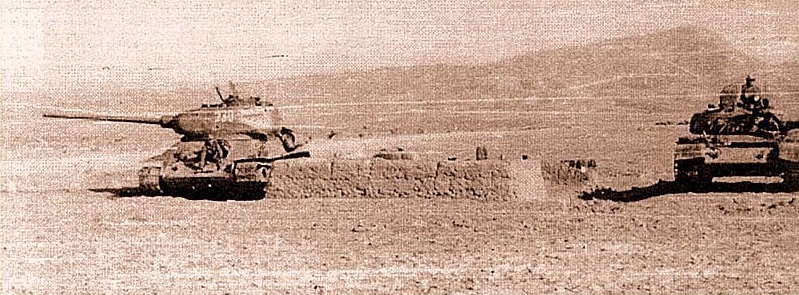 (An WWII-era Aghan T-34, to the left, maintains a static defensive position next to a 1960s-vintage Soviet T-62 during the 1980s war.)
(An WWII-era Aghan T-34, to the left, maintains a static defensive position next to a 1960s-vintage Soviet T-62 during the 1980s war.)
 (Soviet troops next to an Afghan T-34 which was knocked out defending the Shiga Gorge in December 1984.)
(Soviet troops next to an Afghan T-34 which was knocked out defending the Shiga Gorge in December 1984.)
By 1984, the DRAA itself was in near-collapse and the T-34 maintenance effort was the least of it’s worries. That year, East Germany shipped some T-34 spare parts still in it’s warehouses to Afghanistan to get at least some of the T-34s back into action. Because of the postwar German apprehension regarding military endeavors abroad, the spare parts transfer was kept secret and was not known in the west until 1989. The effort was for naught anyways as by the end of 1987, all of Afghanistan’s remaining T-34s were non-operational. The Soviets withdrew the following year, ending the war.
 (This inoperable Afghan T-34 was erected as a monument by Soviet engineers during the 1980s. It has “starfish” wheels, which were often retrofitted to T-34s in the 1950s. The Taliban desecrated the monument during the late 1990s, removing the plaque, so it’s unknown what it commemorated.)
(This inoperable Afghan T-34 was erected as a monument by Soviet engineers during the 1980s. It has “starfish” wheels, which were often retrofitted to T-34s in the 1950s. The Taliban desecrated the monument during the late 1990s, removing the plaque, so it’s unknown what it commemorated.)
Very little of the once-sizable Afghan T-34 fleet survived the 1979-1988 war. During the “warlord period” between 1992-1996, a few were put back into use, usually being destroyed. No operational T-34 was encountered by American troops in 2001, however long-wrecked T-34s were not a rare discovery.
 (This T-34 carcass is one of the more famous ones in Afghanistan. It is located near the tomb of the freedom fighter Ahmad Shah Massoud, who was murdered by al-Queda in September 2001 about forty hours before the 9/11 attacks in the USA.)
(This T-34 carcass is one of the more famous ones in Afghanistan. It is located near the tomb of the freedom fighter Ahmad Shah Massoud, who was murdered by al-Queda in September 2001 about forty hours before the 9/11 attacks in the USA.)
TANKETTES
The CV-35
During the 1930s, Afghanistan bought a small number of these 3-ton tankettes from fascist Italy. At that time, the tankette concept was quite popular worldwide. Experiences in WWII showed them to be a poor bet on the battlefield. The CV-series was one of the most successful tankettes commercially, racking up sales as far away as China to Nicaragua. The CV-35 had a two-man crew and a top speed of 26mph. It was armed with a pair of Fiat-Revelli 8mm machine guns. The guns had a very restricted (about 12°) firing arc and basically the whole tankette had to turn to aim. The armor was thin (½” at it’s best points and as little as 4mm elsewhere) offering protection only against light machine guns and rifles.
 The CV-35 was apparently quite popular in the Royal Afghan Army. They were still in use as combat vehicles in the late 1950s. At some point, a few were rearmed with Soviet-made DShK 12.7mm machine guns as the WWII-era Italian ammo was probably running out. Others had the gun ports welded over and were used as driver trainers. The CV-35s were finally retired in the late 1960s or early 1970s.
The CV-35 was apparently quite popular in the Royal Afghan Army. They were still in use as combat vehicles in the late 1950s. At some point, a few were rearmed with Soviet-made DShK 12.7mm machine guns as the WWII-era Italian ammo was probably running out. Others had the gun ports welded over and were used as driver trainers. The CV-35s were finally retired in the late 1960s or early 1970s.
A half-dozen inoperable CV-35s were found by American troops in 2001. Two were refurbished by soldiers at Camp Alamo and stand as decorations at the new Afghan National Army’s Kabul Training Center, and two more were refurbished by Italian troops of the NATO force.
The UC
The three ton, 12′-long UC (commonly called the Bren Gun Carrier) is well known; it was the most-built armored vehicle of any type during WWII. It saw service with the allies in every theater of WWII. It had a three-man crew and a top speed of 30mph, and as it’s name implies was armed with a Bren machine gun. Little is known about Afghan’s Bren Gun Carriers. They were most likely acquired when the British army withdrew from India in 1947. It’s unknown how many were used by the Afghans.
 (The Bren Gun Carrier is to the left in this photo; the vehicle in center is a CV-35. This was at the communist-era museum mentioned earlier, which was destroyed by the Taliban in the 1990s.)
(The Bren Gun Carrier is to the left in this photo; the vehicle in center is a CV-35. This was at the communist-era museum mentioned earlier, which was destroyed by the Taliban in the 1990s.)
ARMORED CARS / HALF-TRACKS
The Citroen-Kegresse M23
This was a very surprising find by American troops in 2001. The M23 half-track was an interwar French vehicle of low production, with most being destroyed during WWII. The M23 was armed with a Puteaux 37mm main gun and a Hotchkiss 7.9mm machine gun. It had a top speed of just 14mph.
 It’s completely unknown how these half-tracks ended up in Afghanistan or when. They were probably out of service already by the early 1950s. Wreckage of two M23s was found in a Kabul junkyard. One of the two is relatively intact.
It’s completely unknown how these half-tracks ended up in Afghanistan or when. They were probably out of service already by the early 1950s. Wreckage of two M23s was found in a Kabul junkyard. One of the two is relatively intact.
The Lancia 1ZM
Afghanistan purchased a number of these armored cars from Italy at the same time as the CV-35 tankettes. The 1ZM weighed about four tons and had a six-man crew. It had a 40hp gasoline engine and a top speed of 30mph on level paved roads, less off-road. There were fittings for two machine guns, of which a large number of types were compatible.
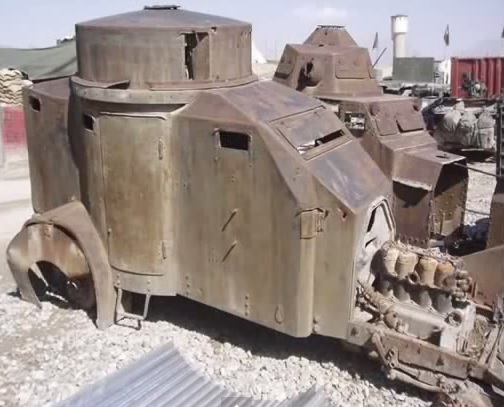 (A Lancia IZM armored car which was found in 2001 about five miles east of Kabul. Behind it is a M23 half-track.)
(A Lancia IZM armored car which was found in 2001 about five miles east of Kabul. Behind it is a M23 half-track.)
The IZMs were still in use as late as the 1950s, by which time they were hopelessly obsolete in any sort of military role. The remains of two, one relatively intact, were found by American troops in 2001.
OTHER WWII VEHICLES
The Dodge WC51
A few of these WWII-veteran 4×4 scout cars were acquired in the late 1940s. They remained in use until the mid-1960s. They were 13’11” long, and powered by a 76hp Dodge T214 gasoline engine with a top speed of 54mph. The below photo was taken in 1959, when a WC51 was used as a reviewing vehicle by the king.
The ACV-IP Mk.IV
The Armored Carrier, Wheeled – Indian Pattern (AVC-IP) was a series of light 4×4 armored vehicles produced in British Raj India during WWII. They had a 95hp Ford gasoline engine and could reach 50mph. It’s unknown how many Afghanistan used, but at least a half-dozen were in use at one point. They were most likely obtained in 1947 along with the Bren Gun Carriers.
The example above was at the 1980s communist-era military museum in Kabul which was later destroyed by the Taliban. In 2001, wreckage of two ACV-IP Mk.IVs was found by American troops about five miles east of Kabul.
WWII-ERA ANTI-AIRCRAFT DEFENSES
Searchlights
In the late 1940s, the Royal Afghan Army bought several WWII-veteran ZiS-12 searchlight vehicles from the USSR. Manufactured between 1943-1945, the ZiS-12 was an adaptation of the basic WWII ZiS-5 cargo truck.
 By the 1950s, almost every country in the world was switching from searchlights to radar for direction of AA gunnery, however Afghanistan could not afford radars at that time so the obsolete ZiS-12 remained in use. They were last seen in public in the 1950s. The total number in use, their history, and their retirement date will probably never be known, because in 1996 the Taliban burned the entire archives of Afghanistan’s air defense force.
By the 1950s, almost every country in the world was switching from searchlights to radar for direction of AA gunnery, however Afghanistan could not afford radars at that time so the obsolete ZiS-12 remained in use. They were last seen in public in the 1950s. The total number in use, their history, and their retirement date will probably never be known, because in 1996 the Taliban burned the entire archives of Afghanistan’s air defense force.
AA Guns
Also in the late 1940s (maybe at the same time as the searchlights above) a significant number of WWII-veteran 61-K towed AA guns were bought from the Soviet Union.
(WWII-era Royal Afghan Army 61-K guns on parade in Kabul during the 1950s. The crewmen are wearing M18 stahlhelms.)
The 61-K fired the 37x250mm(R)-AA cartridge from a five round magazine. It had a slant range of about 2 miles in the AA role and a ceiling of 21,981′. It could also be used as a ground-to-ground weapon with a range of 2 ½ miles. Even by the 1960s, these guns were hopelessly useless against modern jets however the Afghans retained them for use against helicopters or more commonly, in the ground-to-ground role. Some were still in use during the 1979-1988 war against the mujahideen.
The 61-K was the only WWII-era AA gun used by the Afghans. Later purchases were of the postwar-design S-60 and in 1965, the country began a switch to surface-to-air missiles.
WWII-ERA ARTILLERY
When judging the obsolescence of Afghanistan’s WWII-castoff artillery, it’s important to remember what it replaced. The below photo shows Schneider cannons being towed by horses in the late 1930s. These turn-of-the-century antiques served on into the 1940s. The crews are wearing M18 stahlhelms. 
The BS3 / M1944
This 100mm towed artillery piece was one of the most powerful field guns of WWII. It’s 35 lb shell could penetrate 6″ of hardened steel at 1,100 yards and in a bombardment role, it had a range of 12 miles. Afghanistan acquired it’s BS3s along with the SU-76 buy in the early 1950s.
 (A 1959 military parade in Kabul, with a post-WWII Zil-151 truck towing a WWII-veteran BS3. The artillerymen are wearing M18 stahlhelms, and the trucks are equipped with a Soviet-made DShK 12.7mm AA gun.)
(A 1959 military parade in Kabul, with a post-WWII Zil-151 truck towing a WWII-veteran BS3. The artillerymen are wearing M18 stahlhelms, and the trucks are equipped with a Soviet-made DShK 12.7mm AA gun.)
The BS3 was tasked with every imaginable artillery function by the Afghans, as it was their most powerful field gun. These weapons were still in use during the 1979-1988 war against the mujahideen.
The ZiS-3
The Soviet 76mm ZiS-3 anti-tank gun was manufactured between 1941-1945, and saw heavy use during WWII, and was one of Josef Stalin’s favorite weapon systems. It weighed 1 ¼ tons and fired a 6 lb shell out to about 2 miles, or a HE shell out to about 12 miles.
 (A WWII-veteran communist Afghan ZiS-3 gun in action against the mujahideen in 1982. The tow vehicle is a Cold War-era GAZ-66 truck.)
(A WWII-veteran communist Afghan ZiS-3 gun in action against the mujahideen in 1982. The tow vehicle is a Cold War-era GAZ-66 truck.)
Despite being designed as an anti-tank gun, the Afghans used the ZiS-3 for all artillery tasks, although it’s maximum 37° elevation made it a poor choice for long-range fire support. Entering service in the late 1940s, it never left Afghan use. By the 1960s it was already outclassed by the armor of modern tanks but was still useful as a close-range gun, especially in the mountains.
The ZiS-3 was used by the DRAA until the collapse of the central communist government in 1992. Thereafter, the former army’s remaining examples were split up between the various warlords, until the Taliban took over in 1996. The Taliban continued to use the dwindling number against the Northern Alliance up until the time of the 2001 American invasion.
 (This contraption is the chassis of a Cold War-era BMP-1 armored personnel carrier, with it’s turret removed and replaced with a platform for a WWII-era ZiS-3 gun taken off it’s carriage. Bizarre set-ups like this were not uncommon in the Taliban’s arsenal during the late 1990s. The vandalism was done after the Taliban was ejected from power in 2001.)
(This contraption is the chassis of a Cold War-era BMP-1 armored personnel carrier, with it’s turret removed and replaced with a platform for a WWII-era ZiS-3 gun taken off it’s carriage. Bizarre set-ups like this were not uncommon in the Taliban’s arsenal during the late 1990s. The vandalism was done after the Taliban was ejected from power in 2001.)
Throughout 2001-2002, the United States military collected some ZiS-3s from the defeated Taliban and former Northern Alliance. Amazingly, some of these WWII anti-tank guns were re-issued to the new Afghan National Army when it was re-established.
 (An Afghan National Army ZiS-3 being towed by a Bundesheer Dingo of the German NATO contingent in 2011.)
(An Afghan National Army ZiS-3 being towed by a Bundesheer Dingo of the German NATO contingent in 2011.)
This is the conclusion of a three part series. Part I looked at WWII firearms in Afghan service, and Part II at WWII-era uniforms.


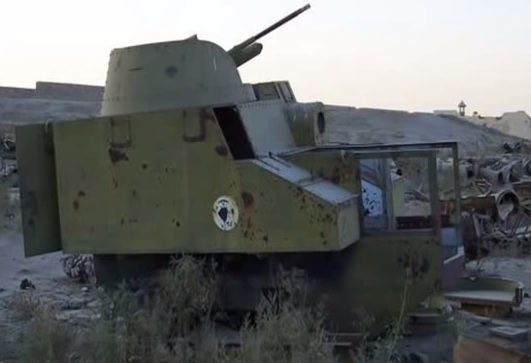




[…] and Kingston Montgomery Winget, both US soldiers in Afghanistan in 2015 Esotericarmour.blogspot wwiiafterwwii.wordpress britishlibrary.typepad aviarmor.com g503.com forums network54.com forums overlord-wot.blogspot […]
LikeLike
Nice article! Only one little correction: the Dingo towing the ZiS-3 is from the Bundeswehr. The Bundesheer being Austrian, not German.
LikeLike
Man, this didn’t age well…
LikeLiked by 1 person
LOL Right?
When I started wwiiafterwwii I made a decision that I wasn’t going to constantly update older entries. It is depressing how some of these situations (Syria too) either dragged on or turned out.
LikeLike
Yeah, it wasn’t a criticism. Just a depressing observation.
LikeLiked by 1 person